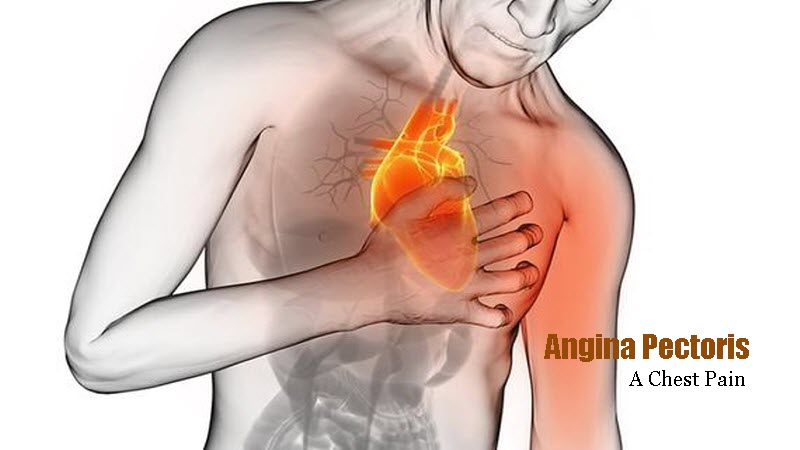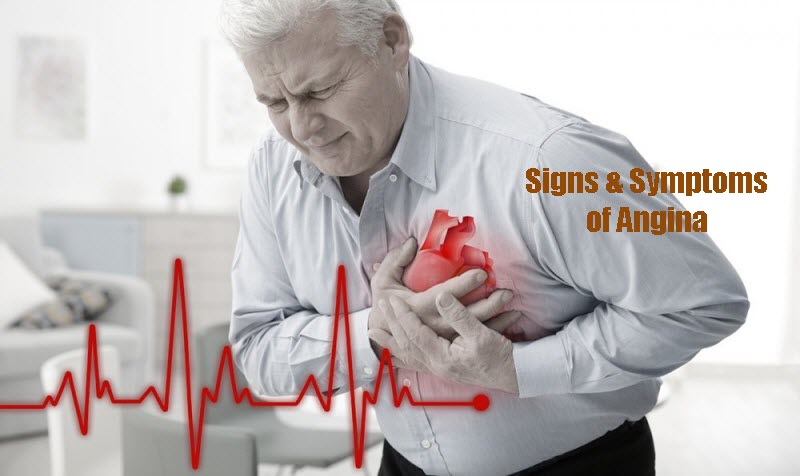This discussion includes the following information related to Angina Pectoris:
- Angina Pectoris or Angina
- Signs and Symptoms of Angina Pectoris
- Causes of Angina Pectoris
- Types of Angina
- Risk Factors for Angina Pectoris
- Complications of Angina Pectoris
- Tests and Diagnosis for Angina
- Treatment and Drugs for Angina Pectoris
Angina Pectoris Definition

Angina is a term used for chest pain caused by reduced blood flow to the heart muscle. Angina is a symptom of coronary artery disease. Angina is typically described as squeezing, pressure, heaviness, tightness or pain in your chest.
Angina, also called angina pectoris, can be a recurring problem or a sudden, acute health concern.
Angina is relatively common but can be hard to distinguish from other types of chest pain, such as the pain or discomfort of indigestion. If you have unexplained chest pain, seek medical attention right away.
Signs and Symptoms of Angina Pectoris

Symptoms associated with angina include:
- Chest pain or discomfort
- Pain in your arms, neck, jaw, shoulder or back accompanying chest pain
- Nausea
- Fatigue
- Shortness of breath
- Sweating
- Dizziness
The chest pain and discomfort common with angina may be described as pressure, squeezing, fullness or pain in the center of your chest. Some people with angina symptoms describe angina as feeling like a vise is squeezing their chest or feeling like a heavy weight has been placed on their chest. For others, it may feel like indigestion.
The severity, duration and type of angina can vary. It’s important to recognize if you have new or changing chest discomfort. New or different symptoms may signal a more dangerous form of angina (unstable angina) or a heart attack.
Stable Angina is the most common form of angina, and it typically occurs with exertion and goes away with rest. If chest discomfort is a new symptom for you, it’s important to see your doctor to find out what’s causing your chest pain and to get proper treatment. If your stable angina gets worse or changes, seek medical attention immediately.
Characteristics of stable angina:
- Develops when your heart works harder, such as when you exercise or climb stairs
- Can usually be predicted and the pain is usually similar to previous types of chest pain you’ve had
- Lasts a short time, perhaps five minutes or less
- Disappears sooner if you rest or use your angina medication
Characteristics of unstable angina (a medical emergency):
- Occurs even at rest
- Is a change in your usual pattern of angina
- Is unexpected
- Is usually more severe and lasts longer than stable angina, maybe as long as 30 minutes
- May not disappear with rest or use of angina medication
- Might signal a heart attack
Angina in women
A woman’s angina symptoms can be different from the classic angina symptoms. For example, women often experience symptoms such as nausea, shortness of breath, abdominal pain or extreme fatigue, with or without chest pain. Or a woman may feel discomfort in her neck, jaw or back or stabbing pain instead of the more typical chest pressure. These differences may lead to delays in seeking treatment.
Causes of Angina Pectoris

Angina is caused by reduced blood flow to your heart muscle. Your blood carries oxygen, which your heart muscle needs to survive. When your heart muscle isn’t getting enough oxygen, it causes a condition called ischemia.
The most common cause of reduced blood flow to your heart muscle is coronary artery disease (CAD). Your heart (coronary) arteries can become narrowed by deposits called plaques. This is called atherosclerosis.
This reduced blood flow is a supply problem — your heart is not getting enough oxygen-rich blood. You may wonder why you don’t always have angina if your heart arteries are narrowed due to fatty buildup. This is because during times of low oxygen demand — when you’re resting, for example — your heart muscle may be able to get by on the reduced amount of blood flow without triggering angina symptoms. But when you increase the demand for oxygen, such as when you exercise, this can cause angina.
Types of Angina
Stable angina:
Stable angina is usually triggered by physical exertion. When you climb stairs, exercise or walk, your heart demands more blood, but it’s harder for the muscle to get enough blood when your arteries are narrowed. Besides physical activity, other factors, such as emotional stress, cold temperatures, heavy meals and smoking, also can narrow arteries and trigger angina.
Unstable angina:
If fat-containing deposits (plaques) in a blood vessel rupture and a blood clot forms, it can quickly block or reduce flow through a narrowed artery, suddenly and severely decreasing blood flow to your heart muscle. Unstable angina can also be caused by blood clots that block or partially block your heart’s blood vessels.
Unstable angina worsens and is not relieved by rest or your usual medications. If the blood flow doesn’t improve, heart muscle deprived of oxygen dies — a heart attack. Unstable angina is dangerous and requires emergency treatment.
Variant angina:
Variant angina, also called Prinzmetal’s angina, is caused by a spasm in a coronary artery in which the artery temporarily narrows. This narrowing reduces blood flow to your heart, causing chest pain. Variant angina can occur even when you’re at rest, and is often severe. It can be relieved with medications.


